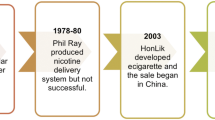Abstract
The present report describes anIntranasalNicotineAerosolDeliveryDevice (INADD) employing an artist's airbrush as aerosolizer and precise, electromechanical control of spray duration. It was designed for the administration of controlled doses of nicotine in a laboratory setting and has been used successfully in over 30 smokers and nonsmokers of both genders. In the present study, nicotine was administered to 12 male smokers at three different doses (0.05 mg, 1.00 mg, and 2.00 mg), and at the same dose (1 mg) on three different occasions. The low dose produced a minimal change in plasma nicotine, while the high dose produced a peak increment of around 16 ng/ml. The medium dose reliably produced a peak increment of around 8–9 ng/ml on all three occasions. Nicotine in plasma showed a sharp rise followed by a slower decline, mimicking the pattern associated with cigarette smoking. Physiological and biochemical responses showed significant dose-response relationships. Subjective reports suggested that aerosol dosing was somewhat aversive, but it is unclear whether this effect is intrinsic to the method or due to other factors. The device described in this report answers the need for a safe and easy means of controlling nicotine dose. Moreover, since nicotine administration via aerosol is novel for both smokers and non-smokers, minimizing the contributions of behavioral tolerance and habituation to the dosing vehicle, it lends itself to the comparison of the pharmacological effects of nicotine between experienced and naive subjects.
Similar content being viewed by others
References
Ashton H, Millman, JE, Rawlins MD, Telford R, Thompson JW (1978) The use of event-related slow potentials of the brain in the analysis of the effects of cigarette smoking and nicotine in humans. In: Battig K (ed) Behavioral effects of nicotine. Karger, Basel, Switzerland, pp 26–37
Benowitz NL (1988) Toxicity of nicotine: implications with regard to nicotine replacement therapy. In: Pomerleau OF, Pomerleau CS (eds) Nicotine replacement: a critical evaluation. Liss, New York, pp 187–217 (Paperback edition: Haworth Press, Binghamton, NY, 1992)
Benowitz NL (1991) Pharmacology of nicotine: tolerance and kinetics. In: Henningfield JE, Stitzer ML (eds) New developments in nicotine-delivery systems. Cortlandt Communications, Ossining NY
Benowitz NL, Jacobs P, Jones TR, Rosenberg J (1982) Interindividual variability in the metabolism and cardiovascular effects of nicotine in man. J Pharmacol Exp Ther 21:368–372
Cherek DR, Bennett RH, Roache JD, Rose JE (1991) Effects of spirometric administration of tobacco smoke containing varying amounts of nicotine on physiological measures and subjects ratings 2:15–22
Fagerstrom K (1978) Measuring degree of physical dependence to tobacco smoking with reference to individualization of treatment. Addic Behav 3:235–240
Feyerabend C, Ings RMJ, Russell MAH (1985) Nicotine pharmacokinetics and its application to intake from smoking. Br J Clin Pharmacol 19:239–247
Gilbert DG, Jensen RA, Meliska CJ (1988) A system for administering quantified doses of tobacco smoke to human subjects: plasma nicotine and filter pad validation. Pharmacol Biochem Behav 31:905–908
Golding J, Mangan GL (1982) Arousing and de-arousing effects of cigarette smoking under conditions of stress and mild sensory isolation. Psychophysiology 19:449–456
Hariharan M, van Noord T, Greden JF (1988) A high-performance liquid-chromatographic method for routine simultaneous determination of nicotine and cotinine in plasma. Clin Chem 34:724–729
Henningfield JE, Woodson PE (1989) Dose-related actions of nicotine on behavior and physiology: review and implications for replacement therapy for nicotine dependence. J Subst Abuse 1:301–317
Kessler DA (1989) The regulation of investigational drugs. N Engl J Med 320:281–288
Lukas SE, Mendelson JH, Amass L, Benedikt R (1990) Behavioral and EEG studies of acute cocaine administration: comparisons with morphine, amphetamine, pentobarbital, nicotine, ethanol and marijuana. In: Harris LS (ed) Problems of drug dependence, 1989. NIDA Research Monograph #95, U.S. Government Printing Office, Washington, DC, pp 146–161
Perkins KA, Epstein LH, Stiller R, Jennings JR, Christiansen C, McCarthy T (1986) An aerosol spray alternative to cigarette smoking in the study of the behavioral and physiological effects of nicotine Behav Res Methods, Instr Comput 18:420–426
Perkins KA, Epstein LH, Stiller RL, Marks BL, Jacob RG (1989) Chronic and acute tolerance to the heart rate effects of nicotine. Psychopharmacology 97:529–534
Pomerleau OF, Pomerleau CS (1984) Neuroregulators and the reinforcement of smoking: towards a biobehavioral explanation. Neurosci Biobehav Rev 8:503–513
Pomerleau OF, Pomerleau CS (1990a) Behavioural studies in humans: anxiety, stress and smoking. In: Bok G, Marsh K (eds) The biology of nicotine dependence. Wiley, Chichester, UK, pp 225–235
Pomerleau OF, Pomerleau CS (1990b) Cortisol response to a psychological stressor and/or nicotine. Pharmacol Biochem Behav 36:211–213
Pomerleau OF, Pomerleau CS, Rose JE (1989a) Controlled dosing of nicotine: problems and progress. Ann Behav Med 11:158–163
Pomerleau OF, Rose JE, Pomerleau CS, Majchrzak MJ (1989b) A noninvasive method for delivering controlled doses of nicotine via cigarette smoke. Behav Res Methods Instr Compu 21:598–602
Rose JE, Ananda S, Jarvik ME (1983) Cigarette smoking during anxiety-provoking and monotonous tasks. Addic Behav 8:353–359
Russell MAH, Jarvis MJ, Feyerabend C, Ferno O (1983) Nicotine nasal solution: a potential aid to giving up smoking? Br Med J 286:683–684
Russell MAH (1988) Nicotine replacement: the role of blood nicotine levels, their rate of charge, and nicotine tolerance. In: Pomerleau OF, Pomerleau CS (eds) Nicotine replacement: a critical evaluation. Liss, New York, pp 63–94 (Paperback edition: Haworth Press, Binghamton, NY, 1992)
USDHHS (1988) The health consequences of smoking: nicotine addiction (1988 Report of the Surgeon General). Public Health Service, Office on Smoking and Health, Rockville MD
Warburton DM, Wesnes K (1978) Individual differences in smoking and attentional performance. In: Thornton RE (ed) Smoking behaviour: physiological and psychological influences. Churchill Livingstone, London, pp 19–144
Zacny JP, Stitzer ML (1986) Effect of puff size instructions of puff volume. Addict Behav 11:17–23
Author information
Authors and Affiliations
Rights and permissions
About this article
Cite this article
Pomerleau, O.F., Flessland, K.A., Pomerleau, C.S. et al. Controlled dosing of nicotine via anIntranasalNicotineAerosolDeliveryDevice (INADD). Psychopharmacology 108, 519–526 (1992). https://doi.org/10.1007/BF02247431
Received:
Revised:
Issue Date:
DOI: https://doi.org/10.1007/BF02247431




